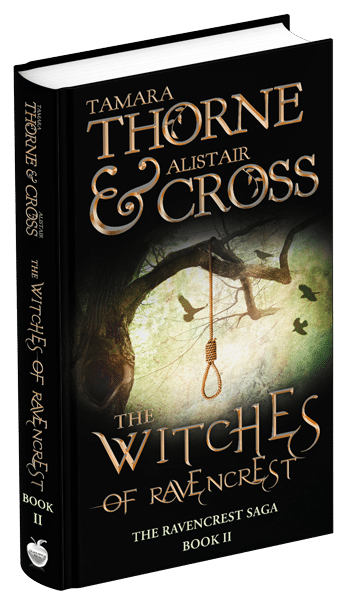A Gothic Recipe for Horror
Home > The Library > The Witches of Ravencrest > A Gothic Recipe for Horror
Ingredients
- 3 cups mystery
- 2 cups ghosts
- 1 cup romance
- ½ cup miscellaneous monstrosities
- All the witches you want
- A whiff of zombies
- 3 bleeding nuns
- A half a cup of looming shadows
- 2 candelabra, with candles
- A pinch of hysteria
- A dollop of sex
- A few drops of blood
Instructions
Sprinkle with a few demented harlequins, stir in an abundance of twisted family history, then mix all of it together in an old spooky mansion on a hill. Add an unsuspecting governess and a mysterious, handsome millionaire, and you’re on your way to creating a good solid gothic. That’s how we did it, anyway.
Gothic novels are all about atmosphere, and to achieve a perfect dish, you can’t just mix these things willy-nilly and expect them to come out gourmet-quality. A good chef – or writer – must use a deft hand to achieve the perfect flavor. First, you need strong characters, proper pacing, and a damned good story – then you stir in the eerie gothic atmosphere.

If you don’t mix your ingredients properly – or if you get creative and don’t carefully consider your extra additions, your cake – or book – may fall flat. Too much – or too little – of anything can ruin what you’re trying to create.
For example, if you add shadows to a sunny day, you must place them in the proper spot to achieve the eerie flavor you desire. Shadows under a tree in summer probably won’t work – unless the tree is situated correctly – perhaps in a lonely cemetery.
What accents should you add?
- A freshly dug grave nearby?
- A mysterious mist hovering just inside the glass door of a nearby family mausoleum?
- Wilted flowers on a grave?
- Or are they fresh but sprinkled with blood?
- Or, did the flowers mysteriously appear when you turned your back?
All these variations provide mystery
- Who – or what – brought the flowers?
- Why is there mist hovering in a mausoleum on a warm sunny day?
- Is someone lurking?
- A human?
- A ghost?
- And what are their intentions? Your answers will affect just how atmospheric your story is.
Consider the definition of Gothic from dictionary.com:
“7. noting or pertaining to a style of literature characterized by a gloomy setting, grotesque, mysterious, or violent events, and an atmosphere of degeneration and decay.”
This very definition screams for an old and spooky residence. For us, it’s a sprawling manor house built centuries ago in England. Already steeped in dark history, Ravencrest Manor was imported stone by stone to the California coast in the early 1800s. It arrived with its sordid past intact, and since then, it has accrued many more mysteries, ghosts, and family secrets.
While Ravencrest Manor is beautifully kept up, it’s still full of long halls and longer shadows – and if you dare enter the door that locks away the forbidden east wing, things intensify. Why the wing was locked up in the first place is a major mystery. Within, flickering lights, dizzying corridors, and some nasty – and nice – spirits all add to the gothic ambience. We’ve already seen a trio of horrible, bloody nuns, the ghost of a little girl, and a headless woman lurking there, just to name a few. The honeycombed rooms contain more horrors than even we know about yet; we feel the presence of spirits and more frightening things as we write and this adds a sense of foreboding for us. And because we feel it, we think our readers will as well.
And those are the most important ingredients in our recipe for ambience and atmosphere in The Ravencrest Saga. Our goal from the beginning was to pay homage to the gothics we teethed on – gothics like Dark Shadows and Rebecca – and in our series’ second full-length novel, The Witches of Ravencrest, we had a particularly good time with atmosphere because not only did we explore more of the mansion itself, but we took some of the story into the town of Devilswood, an old coastal village that serves as the backdrop to the saga.
But whether writing in the gothic genre or not, we’re firm believers that atmosphere is one of the most critical elements to a story. Atmosphere is a reflection of the characters, the locale, and a major influence on the plot itself, so – we believe – there should be no shortage of it.
